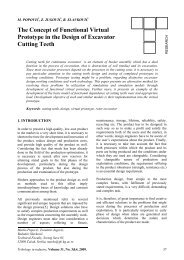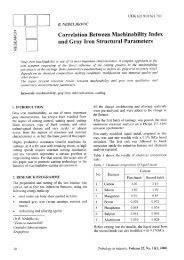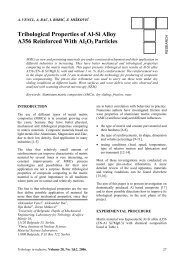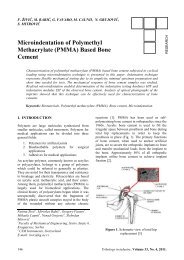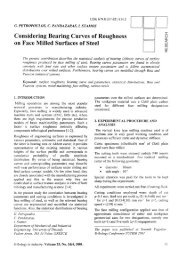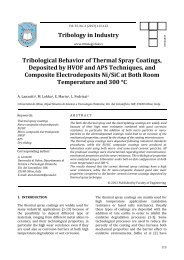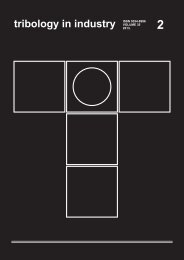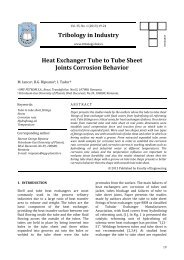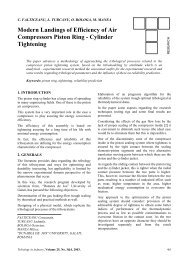No. 4, 1998 - Tribology in Industry
No. 4, 1998 - Tribology in Industry
No. 4, 1998 - Tribology in Industry
You also want an ePaper? Increase the reach of your titles
YUMPU automatically turns print PDFs into web optimized ePapers that Google loves.
Figurc 13. Awiliary f,;ttction gt for detern<strong>in</strong>ation of tlrc<br />
ratio beh+'een energia consunted on frictiort<br />
betwcen the clea<strong>in</strong>g fuce and tlrc nnch<strong>in</strong>ed<br />
piece, and betw,een the chip and the rake face<br />
Figure 14. ALatilian, functiort g t for detenn<strong>in</strong>atiorr of tlrc<br />
ratio bet l,een encryics consutncd ott fticliott<br />
betv'een tlte cleat<strong>in</strong>g face and tlrc nnch<strong>in</strong>ed<br />
piece, and bctw,et:n tlre clip and the rake face<br />
Figure 15. Atuilicry functiort gt for detenr<strong>in</strong>ation of the<br />
ralio hetv,een energies cotrswtted on fricliort<br />
betv,eetr the clzar<strong>in</strong>g face and tl;e nuclt<strong>in</strong>ed<br />
piece, and bef,ueen<br />
qilr,7) = {).76327<br />
9z@):1'933'<br />
IJy substitut<strong>in</strong>g thc ubove uumerical values <strong>in</strong>to the equation,<br />
we obt;l<strong>in</strong>:<br />
A"t 0.0:0 ,,-<br />
) )" ='' i..j' . 0.76-127. 1.933 = 0.05901 6<br />
and the expression further gives:<br />
/'<br />
';; = 0.23529 .(1 + 0.05901A = 0.249176<br />
n^.<br />
so we conclude that <strong>in</strong> the above example the energy of<br />
friction over the clear<strong>in</strong>g face is 5.97o of the energy of<br />
friction over the rake face, and that the enerry offriction<br />
on the contact surfaces on lire rake and the clear<strong>in</strong>g faces<br />
rs 24.9Vo, and the energy for overcom<strong>in</strong>g the <strong>in</strong>ternal<br />
friction is 75.1V of the energy needed for chip formation.<br />
Relatively high normal stress on the contact surface between<br />
the chip and the rake face, has as a consequence<br />
lower<strong>in</strong>g of the friction coefficient, and thus the real<br />
contact surface is <strong>in</strong>creased, over which the micro weld<strong>in</strong>g<br />
will occur betlr,een the asperities on the chip surface<br />
that is slid<strong>in</strong>g over the tool rake face.<br />
The friction conditions cu tire ruke face, as it is shown,<br />
are complicated due to appearance of friction on the<br />
clear<strong>in</strong>g face. Earlier, simplified force schematics, enables<br />
determ<strong>in</strong>ation of the averzrge value of the friction<br />
coefficient on the rake face. It is based on the assumption<br />
about equality and coll<strong>in</strong>eariry of the resultant force and<br />
forces <strong>in</strong> the shear<strong>in</strong>gplane and the rake face (Figure 16).<br />
The friction coef-ficient determ<strong>in</strong>ed <strong>in</strong> this way has not<br />
many comrnon po<strong>in</strong>ts with real condition. The more<br />
realistic scheme is that presented <strong>in</strong> Figure 3.<br />
Consider<strong>in</strong>g the complexity of the tribological conditions<br />
<strong>in</strong> metal cutt<strong>in</strong>g, to



